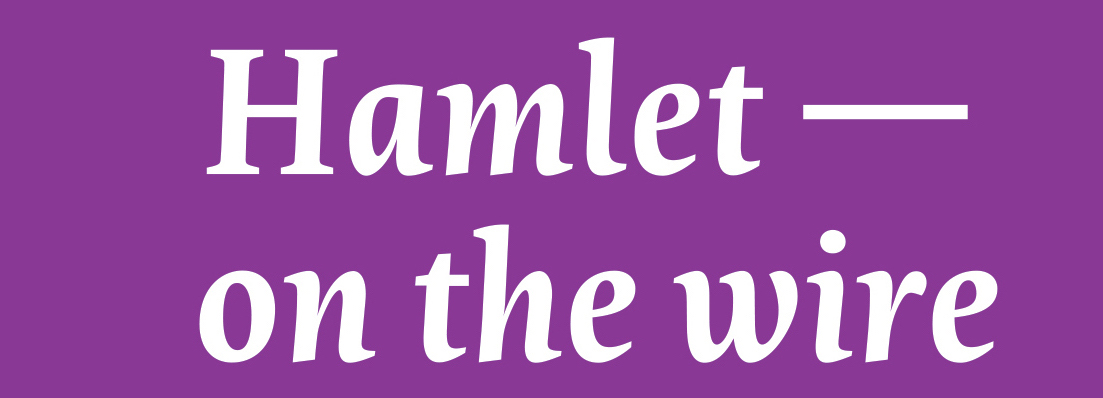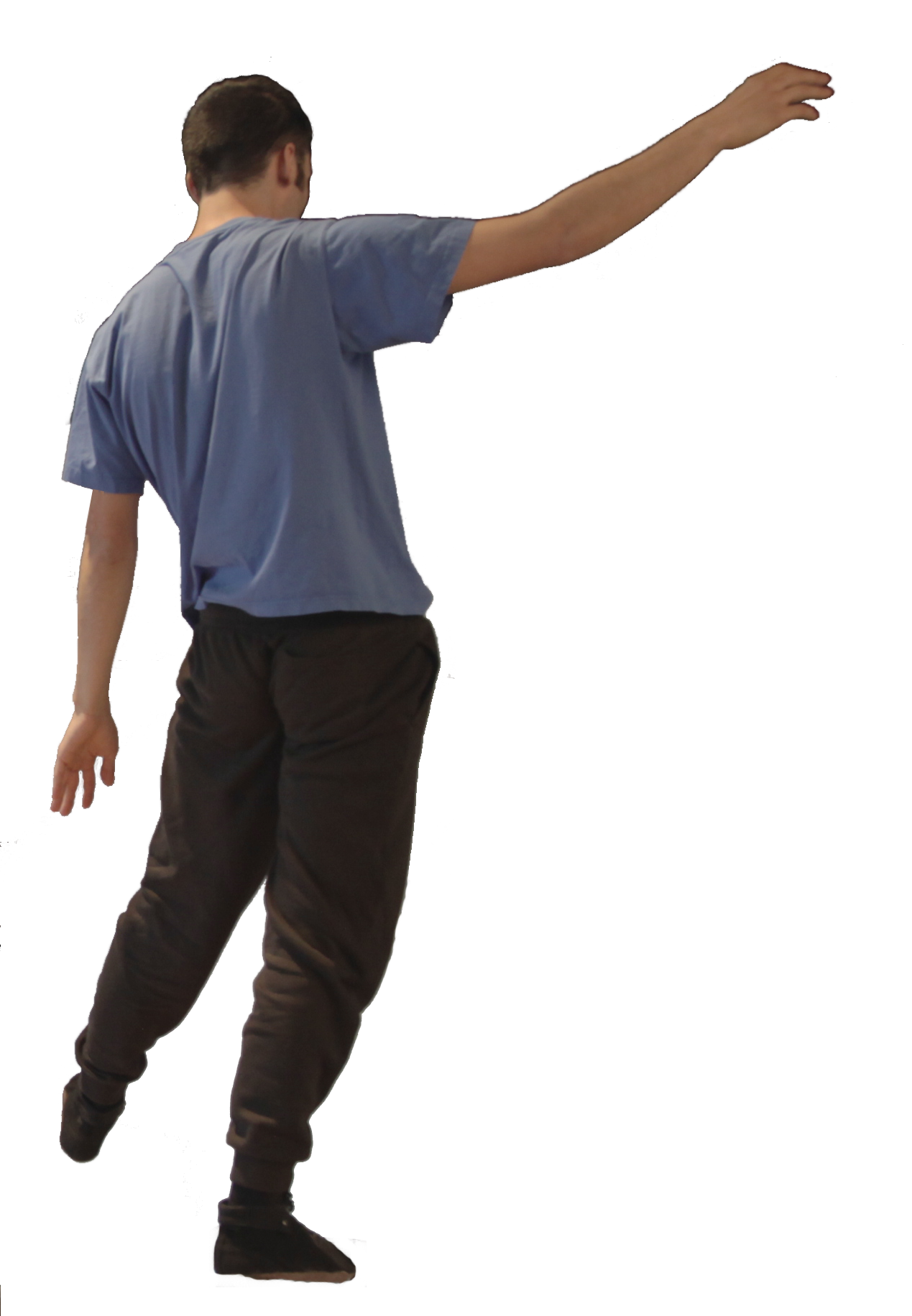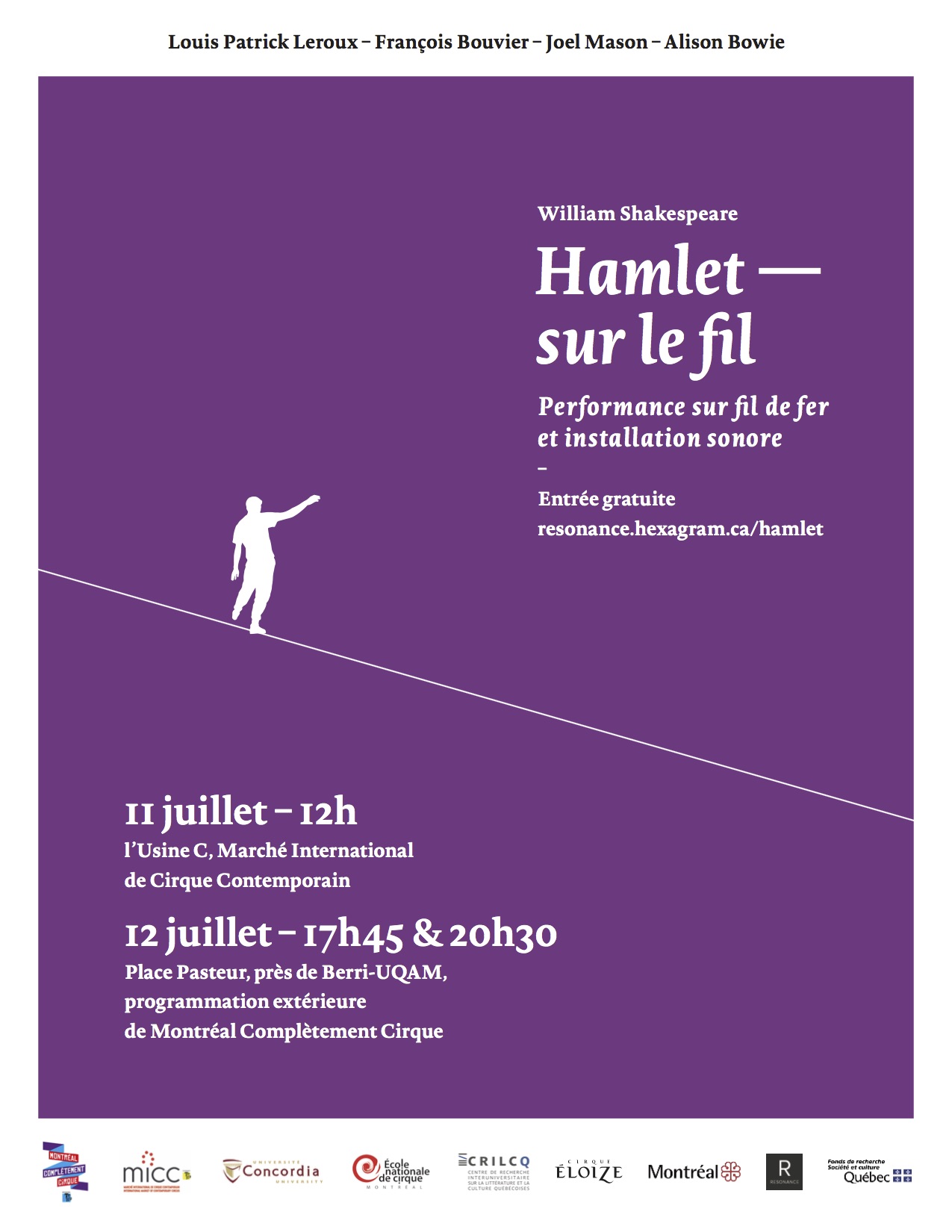In Montréal for July
Monday, July 11, noon, Usine C, International Contemporary Circus Market
Tuesday, July 12, 5:45pm and 8:30pm, Place Pasteur, near Berri-UQAM, outdoor programming for Montréal Complètement Cirque
The project
« To be or not to be », more than just an existential question, the soliloquy plunges us into a waltz of hesitation towards commitment by the individual in relation to himself and to society. Created in June, upon the occasion of the 400th anniversary of Shakespeare's death, this performance explores the possible tensions and dialogue between the voice of Hamlet, modulated and manipulated by a tight wire artist, and the movement of the body and the mind in search of a way out. This project is part of focussed exploration workshops researching circus dramaturgy.
Creators
| |
Louis Patrick Leroux | Direction, conception of sonic installation and additional texts | |
Francois Bouvier | Tight wire acrobat |
| Alison Jane Bowie | Assistant to the direction and dramaturg | |
Adrian Martinez | Acrobatic consultant | |
| |
Joel Mason | Conception and sonic performnace | |
David Blondeau | Intern |
Production and Partners
Louis Patrick Leroux and Jean-Francois Bernard, Producers
Alison Jane Bowie, Direction and production management
 |
 |
 |
 |
 |
 |
 |
Biographies
| |
Dr. Louis Patrick Leroux (Concordia University) Author, director and researcher, Louis Patrick Leroux is an Associate Professor in both the English and French Studies departments at Concordia University. He is the Director and the Founder of the Montreal Working Group on Circus Research and he regularly teaches at the National Circus School. From 2015 to 2018, he is leading, in collaboration with the School, a research-creation project funded by the FRQSC concerning the poetics of contemporary circus (dramaturgies and grammars of writing in movement).
He co-edited Le jeu des positions. Discours du théâtre québécois avec Hervé Guay (Nota Bene, 2014) and Cirque Global: Québec’s Expanding Circus Boundaries with Charles Batson (McGill-Queen’s University Press, 2016). He edited the edition “North-South Circus Circulations” for the American journal Québec Studies (2014) as well as “Désordres et ordonnancements” (2008) and “Le Québec à Las Vegas” (2010) for L’Annuaire théâtral. During the 1990s, he founded and ran Théâtre la Catapulte in Ottawa and co-founded la Nouvelle scène. Louis Patrick Leroux was the writer-in-residence at the Théâtre du Nouvel-Ontario and associate artist-researcher at matralab in Montréal. He is the author and director of numerous plays, including Dialogues fantasques pour causeurs éperdus (2012), Se taire (2010), Le rêve totalitaire de dieu l’amibe (2003), La litière, Rappel et Ressusciter (1996) Le Beau Prince d’Orange (1994) and the performative video installation Milford Haven (2012). |
|
Joel E. Mason (Concordia University) is a PhD in Humanities student at Concordia University. He is a making-thinker based in Montréal, where he creates interactive dramatic events involving circus, affect, whiteness, blackness, improvisation, sociality, music, and political deployments of human voices. |
| |
Alison Jane Bowie (Concordia University) is a PhD in Humanities student at Concordia University, specifically studying Québec theatre and translation. She obtained her Masters of Fine Arts in Dramaturgy at the University of Massachusetts Amherst (USA) and her Bachelor's in History from Queen's University. She is currently Associate Dramaturg for SpiderWebShow and she has taught in the department of theatre at Concordia University. She has also worked in artistic and administrative roles in theatre for nearly ten years. |
|
François Bouvier learned the acrobatic lanauge at a very young age. He began training in gymnastics at age five. Eight years later, he gave up competing in the sport and turned his attention towards classical dance. For a year, he attended the Ecole supérieure de ballet contemporain de Montréal. After that, he attended the National Circus School in Montréal for five years. François obtained his DEC in 20123. Since then, he has been gaining experience tourning with European circuses. In 2014, François was part of the annual tour of Cirque Monti in German Switzerland. In 2015 he participated in the Festival mondial du Cirque de Demain in Paris, where he won the Annie Fratellini award. The same year, he took part in the European tour of NoFit State Circus, joining the show "Bianco". He continues to tour with NoFit State Circus, transporting "Bianco" from Hong Kong to London, by way of New York City.
In 2016, François joined Louis Patrick Leroux's project, Hamlet sur le fil, as the tight wire acrobat. |
|
J.F. Bernard is an assistant professor of English at Champlain College, specializing in Renaissance drama and its philosophical, cultural, and social points of intersection. He is also interested in ideas of cultural production, adaptions, and storytelling, particularly at the relates to contemporary engagements with Shakespeare’s plays. His monograph, Shakespearean Melancholy: Philosophy, Form and the Transformation of Comedy, is forthcoming (Summer 2017) with Edinburgh University Press, as part of their Critical Series on Shakespeare and Philosophy. His current project places notions of contagion, theatrical publicity and narrative in critical dialogue with one another, in an attempt to understand the social, cultural, and conversional impact of the stories produced and circulated by early modern drama. He is the project coordinator for the city of Montreal’s commemoration of the 400th anniversary of Shakespeare’s death and co-producer, along with Louis-Patrick Leroux, of “High Wire Hamlet.” He has not plan, in the near of distant future, to ever a step foot on a high wire.
|
Why?
Louis Patrick Leroux responds to the question : « Why Hamlet? Why Shakespeare? »
Becuase he crossed my path at an opportune moment and I knew that Hamlet would be if not a jovial travel companion, certainly one of substance. I was first asked to remount the Milford Haven installation as part of an event highlighting the 400 years of Shakespeare and in the course of those discussions, the subject of my research in cirus arose. Tentatively, I proposed a Hamlet on a tight wire... "To be or not to be", advancing or retreating, requiring that the poor Dane find himself at the beginning of his soliloquy, otherwise, he would fall... And the idea made its way forward.
Why Shakespeare again? Not to debunk the myth, certainly not to measure myself against him... perhaps, without a doute, to finally enter into a dialogue with a profound and rich interpretation of the world, a world that, behind the appearances of rapid change, remains one of emotion, of thought and ancient inherent impulses. Just as Montaigne scribbled his notes in the margins of the great authors he read, to the point that his comments took centre stage, I can't help but take my own notes, suppositions, and forgeries.

And he talks about the line : « To die, to sleep—No more »
Sleep, no, never sleep again. This is Hamlet's line, but it was equally that of my morose character, Ludwig, from my raging twenties, before I was aware of it. What does it mean to never sleep again? What is the sleep of death? Without a doubt it is the refusal of a life far too focussed on the everyday, on comfort; it the desire to take responsibility to live life fully, even if it means to die through several symbolic words, reinventing oneself, taking control of his destiny.Resonance

What is a resonant response??
The resonant response is the preferred approach by Louis Patrick Leroux in his projects in the Resonance Lab. Before there is a response, there is interpellation and exploration of first impulses of a coherent, relatively fixed, established work, but one that is seeking to be read, a close reading, to be read incorrectly, to its limits, to serve as the trigger for a creative process resting on a series of resonant responses to the sources of the project, in this case, Hamlet, more precisely his timeless soliloquy and his effect on the Western imagination. The responant response is a dialogue with the dead, but not what it dying.What is the research project on circus dramaturgy?
Over the course of three years (2015-2018), thanks to the support of the Fonds de recherche du Québec - Société et culture, a team of researchers, pedagogues, practitioners and students will explore, through the process of research-action and research-creation, the poetics of contemporary circus (dramaturgies and grammars of writing in movement). The research will take place at Concordia University and the Ecole nationale de cirque. The Hamlet on the wire project is part of this research, but is supplementary to the established research program, thanks to the support of additional partners.Click here to go to Resonance Lab.
Click here to go to Montréal Circus Working Group.
Click here to go to l'École nationale de cirque.
Performance
Monday, July 11, noon, Usine C, International Contemporary Circus Market
Tuesday, July 12, 5:45pm and 8:30pm, Place Pasteur, near Berri-UQAM, outdoor programming for Montréal Complètement Cirque
Past Performances
Saturday June 11th, 1:30pm and 5pm in the Atrium Lobby of 1000 de la Gauchetière.
Round Table, Webster Library - Room 322, Concordia University, Saturday June 11th, from 2:30pm to 4pm, with Louis Patrick Leroux, Alison Bowie, Jean-François Bernard, Paul Yachnin, Meredith Evans, Joyce Boro, Jennifer Drouin, Stephen Wittek, Fiona Ritchie, Jenn Long.
Friday June 10th, 12pm and 1pm in the Atrium Lobby of 1000 de la Gauchetière.
Tech Specs
Tight wire performance and sonic environment installation
Duration : 7-8 minutes
Portable self-contained tight wire aparatus, height 1.5 metres, length 5.5 metres. Space required for the performance: 7 metres by 4 metres, minimum.Between four and eight speakers, depending on the configuration for octophonic sound. Sound console. No lighting required.
Installation : 90 minutes. Strike : 30 minutes.


